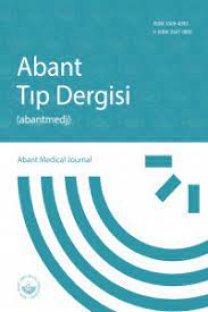Acil Servise Kafa Travmasi ile Başvuran Pediatrik Hastalarin Demografik Analizi
Kafa Travması, Acil Servis, Kafa İçi Kanama, Travma Merkezi, Pediatrik Acil Tıp
Demographic Analysis of Pediatric Patients Presenting To the Emergency Department with Head Trauma
Craniocerebral Trauma, Emergency Service, Intracranial Hemorrhages, Trauma Centers, Pediatric Emergency Medicine,
___
- Langlois JA, Rutland-Brown W, Thomas KE. Traumatic brain injury in the United States; emergency department visits, hospitalizations, and deaths. 2006.
- McCaig LF, Nawar EW. National hospital ambulatory medical care survey: 2004 emergency department summary. 2006.
- McCaig L, Nghi L. National Hospital Ambulatory Medical Care Survey: 2000 Emergency Department Summary. Advance data. 2002;326.
- Marlow R, Mytton J, Maconochie IK, Taylor H, Lyttle MD. Trends in admission and death rates due to paediatric head injury in England, 2000–2011. Archives of disease in childhood. 2015;100(12):1136-40.
- Tuna IC, Akpinar AA, Kozaci N. Demographic analysis of pediatric patients admitted to emergency departments with head trauma/Acil servise basvuran pediatrik kafa travmali olgularin demografik analizi. Eurasian Journal of Emergency Medicine. 2012;11(3):151.
- Babl FE, Lyttle MD, Bressan S, Borland M, Phillips N, Kochar A, et al. A prospective observational study to assess the diagnostic accuracy of clinical decision rules for children presenting to emergency departments after head injuries (protocol): the Australasian Paediatric Head Injury Rules Study (APHIRST). BMC Pediatr. 2014;14:148. Epub 20140613. doi: 10.1186/1471-2431-14-148. PubMed PMID: 24927811; PubMed Central PMCID: PMC4074143.
- Davis T, Ings A. Head injury: triage, assessment, investigation and early management of head injury in children, young people and adults (NICE guideline CG 176). Arch Dis Child Educ Pract Ed. 2015;100(2):97-100. Epub 20141021. doi: 10.1136/archdischild-2014-306797. PubMed PMID: 25335757.
- Tabatabaei S, Seddighi A. Pediatric head injury. Iranian Journal of Child Neurology. 2008;2(2):7-13.
- Jennett B, Bond M. Assessment of outcome after severe brain damage. Lancet. 1975;1(7905):480-4. doi: 10.1016/s0140-6736(75)92830-5. PubMed PMID: 46957.
- ŞAHİN S, DOĞAN Ş, AKSOY K. Çocukluk çağı kafa travmaları. Uludağ Üniversitesi Tıp Fakültesi Dergisi. 2002;28(2):45-51.
- Fylli C, Schipper IB, Krijnen P. Pediatric Trauma in The Netherlands: Incidence, Mechanism of Injury and In-Hospital Mortality. World Journal of Surgery. 2023;47(5):1116-28. doi: 10.1007/s00268-022-06852-y.
- Çıtak Tuna İ, Açıkalın Akpınar A, Kozacı N. Demographic Analysis of Pediatric Patients Admitted to Emergency Departments with Head Trauma. Journal of Academic Emergency Medicine/Akademik Acil Tip Olgu Sunumlari Dergisi. 2012;11(3).
- Brenner DJ, Elliston CD, Hall EJ, Berdon WE. Estimated risks of radiation-induced fatal cancer from pediatric CT. American journal of roentgenology. 2001;176(2):289-96.
- Maguire JL, Boutis K, Uleryk EM, Laupacis A, Parkin PC. Should a head-injured child receive a head CT scan? A systematic review of clinical prediction rules. Pediatrics. 2009;124(1):e145-e54.
- Osmond MH, Klassen TP, Wells GA, Correll R, Jarvis A, Joubert G, et al. CATCH: a clinical decision rule for the use of computed tomography in children with minor head injury. Cmaj. 2010;182(4):341-8.
- Yayın Aralığı: Yılda 6 Sayı
- Başlangıç: 2012
- Yayıncı: Bolu Abant İzzet Baysal Üniversitesi Tıp Fakültesi Dekanlığı
Acil Servise Kafa Travmasi ile Başvuran Pediatrik Hastalarin Demografik Analizi
Sağlık Hizmetlerinin Planlanmasında Multidisipliner Yaklaşım
Geniş Bir Türk Kohortundaki Gastrik Adenokarsinomlarda Claudin 18.2 Ekspresyonu
Aynur IŞIK, Güneş GÜNER, Can ZEYNELOĞLU, Seçil DEMİRKOL CANLI, Hakki TASTAN, Aytekin AKYOL
Fotokromik Senofilcon A Kontakt Lensin Total Göz Aberasyonlarına Etkisi
Deniz KILIC, Muhammed Raşit SİREM, Yunus Naci AZİZ, Semra KOCA, İbrahim TOPRAK
Hasta ile ilk karşılaşma: Yaptıklarım yeterli mi?
Orçun BARKAY, Faruk KARAKEÇİLİ
Blaschko Çizgilerine Yerleşen Lineer Liken Planus: Olgu Sunumu
Tuna SEZER, Feyza Nur ŞİMSEK, Eda Hilal İMAMOĞLU
Çocuklarda akut semptomatik nöbetin oldukça nadir bir nedeni: Kayısı çekirdeği yutulması
Hemoliz Nedeni Olarak Diyalizörler
Radyolojik Olarak Covid-19 Pnömonisi Düşünülen Hastalarda Antikor Düzeylerinin Değerlendirilmesi
Gözde ÖKSÜZLER KIZILBAY, Serap ARGUN BARIŞ, Emel AZAK KARALİ, Aynur KARADENİZLİ, Hüseyin UZUNER, Sevtap DOĞAN, Haşim BOYACI, İlknur BAŞYİĞİT
